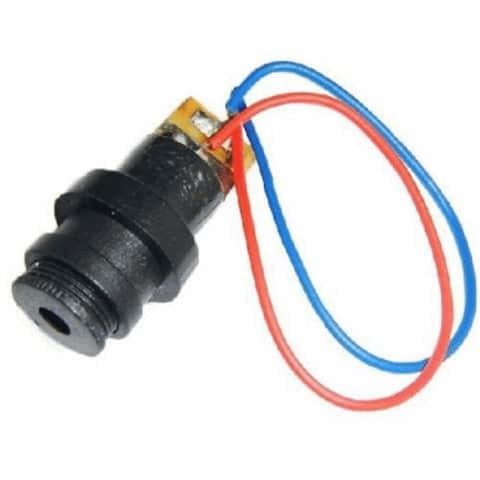4.5V DC Red Dot Laser Head
Internal Reference:
DL-024
4.5V DC Red Dot Laser Head
This laser dot module operates on a low 4.5V DC, and emits a common 650nm wavelength light (Red) in a precise line, with very little divergence over both short and long distances. It is made from brass and lightweight plastic to offer the best of both worlds in terms of durability and space efficiency, with a simple 2-wire connection style to ensure that it also offers a good level of versatility for a wide range of applications.
Laser Specs:
- Light Wavelength: 650mn
- Laser Shape: Dot
- Material Composition: Plastic and Brass
- Lead Length: 7cm
- Head Maximum diameter: 12mm
- Rotating parts diameter: 8.2mm
- Device parts Length: 23mm
- Operating voltage: 4.5 V 51 Resistance
- Optical Power: 5mW
How Do They Work?
Lasers produce highly coherent, directional beams of monochromatic light. The basic structure of any laser is based on an active medium (either a gas or semiconductor) contained between multiple reflectors. A laser's reflectors contain light by oscillating it through a medium repeatedly allowing the energy to coherently build up with each pass using a process called stimulated emission. Laser radiation escapes due to a partially reflecting mirror in the assembly. This light can be used for a variety of applications including medical equipment, entertainment projectors, sensing for dynamic measurements, laser manufacturing, positioning, and machine vision.
Specifications of a Laser
Beam Diameter: The beam diameter refers to the diameter of the laser beam measured at the exit face of the laser housing. The beam diameter can be defined in several different ways, and for Gaussian beams it is typically described by the 1/e2 width. The 1/e2 width is the distance between the two points on the marginal distribution whose intensities are 1/e2 = 0.135 times the maximum intensity value.
Beam Divergence: While laser beams are assumed to be collimated, they always diverge to a certain degree. The beam divergence defines how much the beam spreads out over increasing distance from the optical aperture. Beam divergence is defined by the full angle. In laser diodes, beam divergence is specified with two values because of the presence of astigmatism (see Diodes vs. HeNe). In this case the orientation of the beam divergence needs to be specified.
Output Power: The output power specified is the maximum power value of the laser light after the beam exits the laser housing. In other words, power is rated before passing through any optics outside of the laser housing. Values stated are typically within +/-10%. The light intensity typically has a Gaussian profile, meaning the intensity is highest at the center of the beam and dissipates radially outwards.
Class: This is the CDRH (Center for Devices and Radiological Health) warning label required on all laser products. The class designation corresponds to the maximum amount of laser radiation emitted from the laser at a specific wavelength.
| Class | Description |
| Class 1 | Non-hazardous. |
| Class 1M | Safe as long as additional optical instruments are not used. |
| Class 2 | Safe for accidental exposure < 0.25s. The natural reflex blink will prevent this from damaging the eye. |
| Class 2M | Safe for accidental exposure < 0.25s as long as optical instruments are not used. |
| Class 3R | Momentarily hazardous. |
| Class 3B | Hazardous. Viewing of diffuse reflection is safe. |
| Class 4 | Hazardous. Viewing of diffuse reflection is also hazardous. Fire risk. |
(Center for Devices and Radiological Health, 2017)
Detectability/Visibility: The visibility of the laser spot (when viewed by your eye or another detector) depends on the signal-to-noise ratio (SNR). SNR is the ratio of the signal power of the laser to the noise from background non-laser illumination. Higher SNR values mean that the laser spot is more detectable. For visual applications, the closer the laser wavelength is to 550nm (green), the brighter it will appear. In detector applications, it is beneficial to use filtering to increase your SNR and perhaps utilize a lens to limit the field of view. Laser wavelengths should be selected to best match a detector's responsivity.
Lifetime: Power supplies should be selected to run at the lowest voltage possible to extend the lifetime of the laser. Heat sinks are recommended and must be used if operating near maximum voltages. Maintaining a diode at the low end of the operating temperature range can also extend the laser’s lifetime. Diode modules typically have a lifetime of 10,000 to 20,000 hours.
